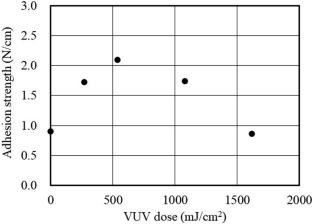In this work, pretreatment with vacuum ultraviolet (VUV) light changed the adhesion strength between an epoxy resin and directly sputtered copper in a printed circuit board manufacturing process. The adhesion strength was 0.9 N/cm without irradiation but had a peak value of 2.1 N/cm at 540 mJ/cm2 of VUV irradiation; with increasing VUV irradiation, the adhesion strength decreased. Based on x-ray photoelectron spectroscopy (XPS) analysis of the copper interface of copper peeled from the resin, we evaluated the abundance ratio of metallic and organic oxygen at interfaces exposed to different VUV irradiation doses. We found that the change in the abundance ratio of metallic and organic oxygen was similar to the change in adhesion strength between copper and epoxy resin after exposure to different VUV irradiation doses. We observed the interface between copper and resin via scanning transmission electron microscopy (STEM) and found a distributed layer of oxygen. The functional group concentration in STEM images suggested the presence of a material with an intermediate density. We used chemically modified XPS to evaluate changes in the functional group concentration on epoxy resin surfaces irradiated with VUV light. We found that the hydroxyl group (OH) formed by VUV irradiation and the copper formed by direct sputtering improved adhesion strength in a synergistic manner. We observed a correlation between OH concentration on the resin surface and adhesion strength. These results will help to optimize the VUV irradiation process for adhesion between epoxy resin and sputtered copper.




